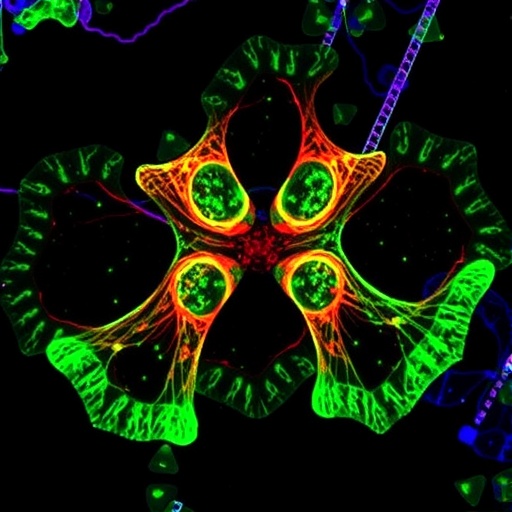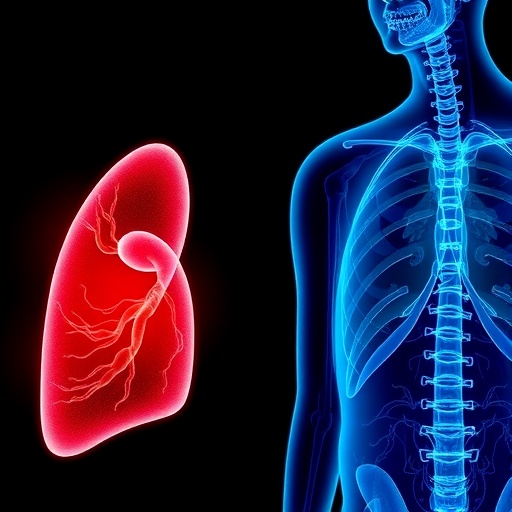A groundbreaking advancement in computational oncology has emerged from the laboratories of Virginia Commonwealth University’s Massey Comprehensive Cancer Center, where researchers have developed an innovative tool, Vesalius, designed to unravel the complex spatial relationships between cancer cells and their surrounding microenvironment. This pioneering AI-powered platform promises to transform our understanding of cancer biology by integrating multi-scale, spatially resolved cellular data to provide clinicians with novel insights into tumor heterogeneity and therapy response.
At the core of Vesalius lies a sophisticated computational framework that interprets vast datasets of spatially mapped cells within tumor tissues, transcending traditional single-cell analysis by focusing on the holistic architecture of the tumor microenvironment. Unlike previous methodologies that dissect tumors into isolated cells, Vesalius conceptualizes cancer as an ecosystem where cell-to-cell interactions critically influence disease progression and treatment outcomes. This paradigm shift allows for a multi-contextual examination of tumor biology, capturing the dynamic interplay among cancer cells, immune cells such as T cells and macrophages, and stromal components within their native spatial coordinates.
The team behind Vesalius, led by Dr. Rajan Gogna of VCU Massey’s Developmental Therapeutics program, embarked on this endeavor motivated by the monumental challenge of interpreting high-dimensional spatial data generated by emerging multiplexed imaging and spatial transcriptomics technologies. “Traditional analytic methods fall short when it comes to capturing the emergent properties of tumor tissues as integrated entities,” explains Gogna. By leveraging advanced artificial intelligence algorithms, Vesalius maps cellular states across heterogeneous spatial samples, enabling the identification of spatial patterns predictive of therapeutic response that were previously obscured by conventional approaches.
A key innovation of Vesalius is its multi-scale analytical capability, permitting simultaneous interpretation of cellular phenotypes from the subcellular to the multicellular neighborhood level. This comprehensive approach acknowledges that cancer cells seldom act in isolation; their behavior is modulated profoundly by nearby fibroblasts and immune populations, which collectively orchestrate the tumor’s evolutionary trajectory. For instance, fibroblasts are known mediators in the tumor extracellular matrix remodeling, influencing both tumor growth and immune evasion. By encompassing these interactions within its model, Vesalius delivers insights into how spatial relationships govern cancer progression and treatment resistance.
Vesalius’s practical applications extend beyond data interpretation; it holds substantial promise for the clinical arena, where personalized oncology depends on precise biomarkers predicting patient-specific responses to therapies. By analyzing spatial cellular patterns unique to responders versus non-responders, Vesalius aids in unveiling predictive biomarkers that underpin these differential outcomes. This capability could revolutionize individualized cancer care by enabling clinicians to stratify patients more effectively and tailor treatment regimens aligned with each patient’s tumor ecology.
The computational backbone of Vesalius incorporates deep learning architectures that continuously refine their predictive accuracy as more spatial datasets become available. This self-training model ensures that the platform evolves in tandem with the burgeoning field of spatial omics, adaptively incorporating novel data types and expanding its clinical utility. Originally validated on breast, colon, and ovarian cancer samples, the system’s design anticipates broad applicability across diverse cancer types, positioning Vesalius as a versatile tool for oncology research and precision medicine.
Crucial to the impact of Vesalius is its ability to handle the immense complexity of spatial data and translate it into actionable insights without overwhelming the end user. Dr. Gogna articulates this challenge: “The inherent complexity of tumor microenvironments demands technologies that not only store data but also distill it into meaningful biological narratives.” Vesalius achieves this by integrating cell-type classification, spatial distribution, and interaction networks into an intuitive mapping that captures the multi-dimensional nature of tumors.
Moreover, Vesalius facilitates a novel conceptual framework to study cancer ecosystems by interpreting cell interactions analogously to long-standing human relationships. Dr. Gogna likens the persistent interaction between fibroblasts and cancer cells to a decades-long marriage, where mutual influence shapes behaviors over time. This analogy underscores the importance of considering temporal and spatial contexts in therapeutic strategy development; disrupting entrenched cellular partnerships requires an understanding of their co-dependencies within the tumor niche.
Cancer research experts emphasize that tools like Vesalius are vital for decoding the complexity underlying treatment resistance, a major hurdle in oncology. The spatial heterogeneity revealed by Vesalius may elucidate why certain subclones within tumors evade immune surveillance or therapy, contributing to disease relapse. Understanding these spatially resolved resistance mechanisms opens avenues for the development of combination therapies that target not only cancer cells but also their supportive microenvironment components.
The potential breakthrough offered by Vesalius extends into the realm of immuno-oncology, where spatial context dictates immune cell infiltration and activation states. By mapping the spatial proximities and interactions between cancer cells and immune effectors such as macrophages and cytotoxic T lymphocytes, Vesalius equips researchers with a more nuanced understanding of immune evasion tactics employed by tumors. This insight is critical for optimizing immunotherapeutic interventions, whose success hinges on modulating the tumor microenvironment.
Importantly, the development of Vesalius represents the convergence of applied mathematics, artificial intelligence, and clinical oncology, demonstrating how interdisciplinary innovation can address complex biomedical challenges. By consolidating large-scale spatial datasets into interpretable, clinically relevant models, the platform exemplifies the next generation of computational oncology tools driving precision medicine forward.
In endorsement of Vesalius’s transformative potential, Dr. Robert A. Winn, director of Massey Comprehensive Cancer Center, highlights the platform’s role in bridging the gap between cutting-edge science and patient outcomes. Through tools like Vesalius, cancer care is poised to become more predictive and adaptive, ultimately reducing the disease burden and enhancing survival prospects across diverse patient populations.
As cancer research increasingly embraces spatial biology, Vesalius sets a new standard for interpreting the intricate cellular landscapes that define tumor behavior. Its innovative fusion of AI and spatial analytics not only deepens scientific understanding but also charts a promising path toward more effective, personalized cancer therapies for the future.
Subject of Research: Computational oncology; spatial mapping of tumor microenvironment; artificial intelligence in cancer research
Article Title: Multi-scale and multi-context interpretable mapping of cell states across heterogeneous spatial samples
News Publication Date: 21-Aug-2025
Web References:
– https://www.nature.com/articles/s41467-025-62782-y
– http://dx.doi.org/10.1038/s41467-025-62782-y
References:
Martin, P.C.N., Wang, W., Kim, H., et al. Nat Commun 16, 7814 (2025).
Image Credits:
Martin, P.C.N., Wang, W., Kim, H., et al. Nat Commun 16, 7814 (2025).
Keywords: Artificial intelligence, Cancer, Algorithms, Data sets, Biomarkers, Gene expression
Tags: AI-powered cancer researchcell-to-cell interactions in cancercomputational oncology advancementshigh-dimensional spatial data interpretationinnovative cancer biology technologiesmulti-layered cancer insightsspatially resolved cellular datatherapy response evaluationtumor heterogeneity understandingtumor microenvironment analysisVCU Massey Comprehensive Cancer Center researchVesalius cancer cell mapping tool





